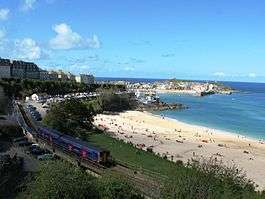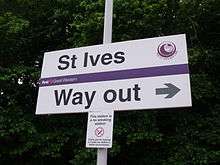St Ives railway station
St Ives railway station serves the coastal town of St Ives, Cornwall, England. It was opened in 1877 as the terminus of the last new broad gauge passenger railway to be constructed in the country. Converted to standard gauge in 1892, it is today served by Great Western Railway services on the St Ives Bay Line from St Erth. It is 325 miles (523 km) from London Paddington via Bristol Temple Meads.
| St Ives | |
|---|---|
 | |
| Location | |
| Place | St Ives |
| Local authority | Cornwall |
| Coordinates | 50.209°N 5.478°W |
| Grid reference | SW519401 |
| Operations | |
| Station code | SIV |
| Managed by | Great Western Railway |
| Number of platforms | 1 |
| DfT category | F1 |
| Live arrivals/departures, station information and onward connections from National Rail Enquiries | |
| Annual rail passenger usage* | |
| 2014/15 | |
| 2015/16 | |
| 2016/17 | |
| 2017/18 | |
| 2018/19 | |
| History | |
| Original company | Great Western Railway |
| Opened | 1877 |
| Resited | 1971 |
| National Rail – UK railway stations | |
| * Annual estimated passenger usage based on sales of tickets in stated financial year(s) which end or originate at St Ives from Office of Rail and Road statistics. Methodology may vary year on year. | |
History

The station was opened by the Great Western Railway on 1 June 1877 as the terminus of a 4.25 miles (6.84 km) 7 ft (2,134 mm) gauge branch line from St Erth which until then had been known as St Ives Road to indicate its position as the railhead for the town.[1] The platform was on a sharp curve with a goods shed behind it. The town end of the platform was used to load railway trucks with fish that were caught by the many local boats, many of which were drawn up on Porthminster beach, just below the station. Immediately outside the station was the 106 yards (97 m) long St Ives Viaduct. A small engine shed was situated on the far side of the viaduct.[2]
The Great Western Railway purchased the Tregenna Castle which was situated on the hill above the station and opened it as a hotel to coincide with the opening of the railway.[1] The railway has played an important part in developing the tourist business in the area.[3]
The line was converted from broad gauge after the last train ran on Friday 20 May 1892; services from the following Monday running as 4 ft 8 1⁄2 in (1,435 mm) standard gauge. On 12 November 1894 heavy rain caused flood water to run down Tregenna Hill. It broke through a wall, flooding down onto the station below from where it cascaded off the other side down on to the beach.[3] The heavy fish traffic of the nineteenth century largely disappeared during the first half of the twentieth century[2] and all goods traffic was withdrawn from the station on 9 September 1963. The signal box was no longer staffed and all the sidings were taken out of use by 1966. A camping coach was positioned here by the Western Region in 1958 and 1959, then there were two coaches from 1960 to 1964.[4]
The line was proposed for closure following the Beeching Report and, because of this, was mentioned in the song "Slow Train" by Flanders and Swann.[5] The line however was reprieved, but the original curved station was closed on 23 May 1971 and a new, straight, platform opened on the site of the goods shed to replace it.[6] The site of the original station is now a car park, but the railway also brings people from the Park and Ride car park at St Erth.
A travel agency immediately adjacent to the station platform contains a rail ticket booking office. Tickets issued to/from the station describe it as "St Ives Cornwall" to distinguish it from the station St Ives in Cambridgeshire (closed in 1970).
Description

The station is situated on the hill above Porthminster beach on the south side of the town. It comprises a single platform which is on the left of trains arriving from St Erth, which is 4.25 miles (6.8 km) to the south. A large car park is situated adjacent to the platform and the town centre is a short walk down the hill from the car park entrance. The town’s small bus station is situated at the car park entrance.
A path leads from the car park down to Porthminster beach, from where the South West Coast Path can be followed back to Carbis Bay or through the town towards Lands End.
Services

All trains are operated by Great Western Railway. All services operate to and from St Erth where connections can be had into trains on the Cornish Main Line. During the daytime there are two services each hour. Only one of these typically calls at Lelant with some gaps. The first and last train of the day (plus an early evening service on Saturday) are extended to Penzance[7] to facilitate crew changes.
| Preceding station | Following station | |||
|---|---|---|---|---|
| Carbis Bay | Great Western Railway St Ives Bay Line |
Terminus | ||
References
| Wikimedia Commons has media related to St Ives railway station. |
- MacDermot, E T (1931). History of the Great Western Railway. 2 (1863-1921) (1 ed.). London: Great Western Railway.
- Bennett, Alan (1990) [1988]. The Great Western Railway in West Cornwall (2 ed.). Cheltenham: Runpast Publishing. ISBN 1-870754-12-3.
- Bray, Lena; Bray, Donald (1992) [1981]. St Ives Heritage (Second ed.). Devoran: Landfall Publications. ISBN 1-873443-06-4.
- McRae, Andrew (1998). British Railways Camping Coach Holidays: A Tour of Britain in the 1950s and 1960s. Scenes from the Past: 30 (Part Two). Foxline. p. 95. ISBN 1-870119-53-3.
- "Flanders & Swann Online". Slow Train. Archived from the original on 13 April 2013. Retrieved 14 May 2009.
- Cooke, R A (1977). Track Layout Diagrams of the GWR and BR WR: Section 10, West Cornwall. Harwell: R A Cooke.
- Table 144 National Rail timetable, May 2019
External links
| This station offers access to the South West Coast Path | |
|---|---|
| Distance to path | 100 yards (91 m) |
| Next station anticlockwise | Penzance 41 miles (66 km) |
| Next station clockwise | Carbis Bay 1 mile (2 km) |